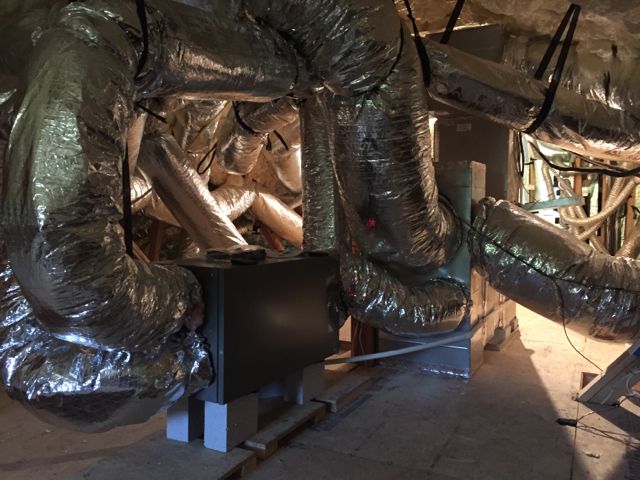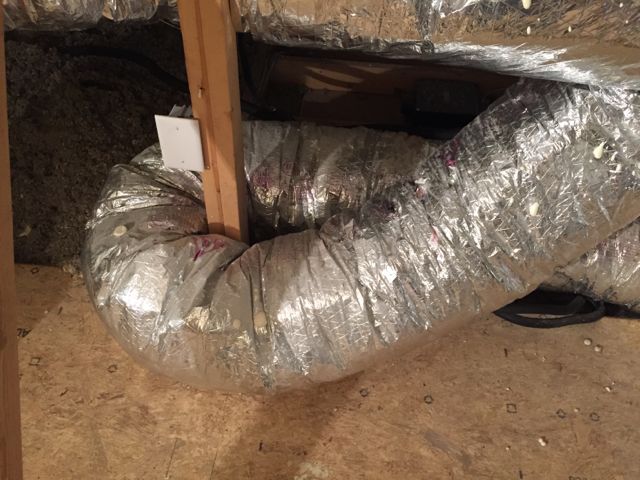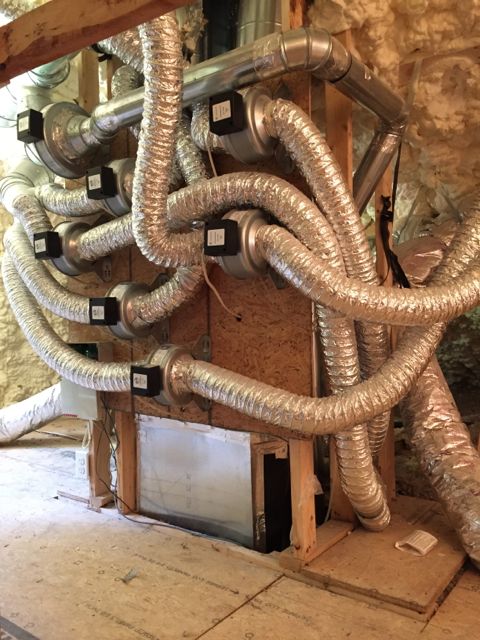My New Favorite Duct Disaster

WARNING: This article contains graphic and disturbing images of a duct system that may upset anyone sensitive to low-quality air distribution. If you’ve ever experienced nausea, fainting spells, or outbursts of anger upon being exposed to such stimuli, I urge you to take this in small doses…or not at all.
This is my new favorite ductopus photo. I’ll always have a soft spot in heart for The Kraken, but wow! Just look at this thing. It looks like it could have been used in a scene in the movie Brazil. When I posted this photo on our Facebook page, one of the commenters wrote, “I would use one of those ducts to strangle the designer then the installer.”

One part of that system you can’t see in the top photo is this nice little twist in a return duct. Just think of the time they saved by not having to cut that duct to length. And I’ll bet the homeowners will never complain of blower noise coming through that vent.

If you were wondering about that tangle of smaller flex ducts in background on the right side of the top photo, here’s a closeup for you. Those are the bath fans for one side of the house. (There’s more in another attic.) When I showed this photo to someone at Building Science Summer Camp last week, they thought this must be a multifamily project. It’s not.
You’d think that people designing and installing duct systems to move air might know a little about how to do it properly. I know some contractors who can do it right, but unfortunately they’re in the minority. Photos like the ones above are far too easy to find to conclude otherwise.
Allison A. Bailes III, PhD is a speaker, writer, building science consultant, and the founder of Energy Vanguard in Decatur, Georgia. He has a doctorate in physics and writes the Energy Vanguard Blog. He also has a book on building science coming out in the fall of 2022. You can follow him on Twitter at @EnergyVanguard.
Related Articles
Release the Kraken! — The Ductopus Is Bad for Air Conditioning
How to Install Flex Duct Properly
The 2 Primary Causes of Reduced Air Flow in Ducts
NOTE: Comments are moderated. Your comment will not appear below until approved.
This Post Has 18 Comments
Comments are closed.

Allison – those are great,
Allison – those are great, particularly the bath venting – Just wow
Only place I could find to
Only place I could find to submit a comment. Is that unit really just sitting on four concrete blocks, on end, as it appears? If so, it is a violation of the law in a bunch of places. Hope they are not in a state with earthquakes… which would rule out all 50.
Is that an ERV in the first
Is that an ERV in the first photo?
Is that an ERV in the first photo with a duct connecting one side of the ERV to the other? Surely that’s just an optical illusion from the picture, surely that’s not really what that is?
How many bathrooms are in that house!?
Yes, Leigha, it is an ERV. No
Yes, Leigha, it is an ERV. No, it’s not short-circuiting from one side to the other. It does have other problems, though, like pulling intake air off the roof.
Not sure how many bathrooms there are, but I think there may be more than one fan in some of them.
Wow- they spent all of that
Wow- they spent all of that money on spray foam insulation and an ERV and ended up with that ductdaster! I feel sorry for the homeowners.
Allison, Why are you so picky
Allison, Why are you so picky?
You should learn to catch people doing something right. Are they not licensed? Didn’t this pass inspection? Was the contractor credentialed? Did they complete their Energy Star Checklists. Do they own Wrightsoft software? Did they take the 4 hour class to properly design HVAC systems. Let’s stick to substance here. Remember, you can plant more in a crooked row than in a straight one. :>)
Allison, you get all the best
Allison, you get all the best! At least it looks like the ducts are “inside the conditioned space” so all those bath fan uninsulated bath fan ducts may have less water in them. The bell housings on the inlines can collect lots of water when they are mounted horizontally like that. Simply amazing! Thanks for sharing.
My favorite is the one piece
My favorite is the one piece of hard duct (is that the vent for a an open-combusion furnace or a fan????) is carefully foil-taped in a couple spots, but then has an obvious “slip-fit” joint GOING THE WRONG DIRECTION just upstream…. I’m not trained or certified in any HVAC domain, but the engineer in me is having a hard time finding much anything right about the techniques used here.
I bet the homeowner spent the
I bet the homeowner spent the money on granite counters, ridiculously expensive bath fixtures, chandeliers, Viking range and all the other eye candy they are told/feel they need. They got what they paid for with this system more than likely. When a builder asks me to price a new HVAC install, I usually tell him “only if I can meet the homeowner first”…that usually ends that conversation. I see crap systems like this as my retirement fund…keep them coming!
How did that piece of hard
How did that piece of hard pipe get in there? Did they run out of flex?
Looks like a bigger in-line
Looks like a bigger in-line fan on that one. Maybe the flex duct was collapsing so they put in a rigid duct?
Thanks Allison, now I’ll be
Thanks Allison, now I’ll be having nightmares.
A lot of old school HVAC guys
A lot of old school HVAC guys do need to be “Bailed” out of their old ways, to the current efficient days! Again thanks for sharing and caring!
@EnergyCircle tweeted during
@EnergyCircle tweeted during David Hill’s presentation:
“The craft of sheet metal is dying with the generation that is now retiring. David Hill at #bscamp.”
To which I replied:
“Flex duct syndrome. Each time we make it easier to install, we make it easier to get bad results.”
That evening in Joe’s backyard this topic arose again, and I mentioned “flex duct syndrome”, and how it can also be seen in the adoption of CSST (corrugated stainless steel tubing) to replace black iron pipe for natural gas piping in a house. Easier to install, easier to run it where roofing or drywall nails punch a hole into it, filling an attic or wall cavity with explosive gas.
The craft of sheet metal and other crafts are dying because the demand for these crafts is diminishing, largely replaced by “string it out and hope for the best” mentality that unfortunately so often follows a material like flex duct and CSST.
The original intent for flex duct was to be the final short run of duct between a metal branch and a diffuser in a suspended ceiling. Personally I think that application is where flex should have remained. Yes, it can be installed properly as an all-flex system in a residence, but how often is that done? So often this stuff is installed in hot weather, and installers want to get it in and themselves out of the attic as soon as possible. Careful attention to detail tends to slip in this environment.
All of this discussion only strengthens my case for getting ducts and air handlers out of the attic altogether. Just a matter of getting home buyers and builders to realize the value of HVAC and ducts in conditioned space far exceeds the small sacrifice of square footage to accommodate it. Time to let go of 20th century archaic practices (based on the myth of perpetually cheap energy and resources)
Allison,
Allison,
A few questions.
How did you come by the photos?
Did you become involved in any way?
Has the photographer who iPhoned the photos out of that flex duct jungle been rescued or are they still MIA?
i purchased a bryant split
i purchased a bryant split air system less than two years ago. the day after it was installed it showed on the thermostat that the co istalled humidity of 77%. this continued so the co came out & changed the theromstat and said that the filter i was using was too good and gave me a box of cheap filters. when the air cycles on the humidity starts at its lowest and at the end at the hightest. it was tested by someone else and actually showed 88.9% humidity at the end of the air cycle.i also now have a mold problem &poor air quality. any suggestions please?
teresa,
teresa,
Where are you reading those relative humidity numbers? If it’s in the air coming off the coil or right out of the supply vent, it’s probably fine. Relative humidity doesn’t really tell you how humid the air is unless you also know the temperature. For 60° F air at 80% RH, the dew point is about 54° F. Air conditioned to design conditions (75° F and 50% RH) has a dew point of 55° F, so you’re right there. See my article on this:
The Problem with Relative Humidity
http://www.energyvanguard.com/blog-building-science-hers-bpi/problem-with-relative-humidity
If, however, the air in the room is hitting 77% or 89% at normal room temperatures of ~75° F, then you have a problem.
Just to add to the silliness,
Just to add to the silliness, one sees the attic roof beyond, non insulated. So all this is triple loss for the owner.
Whoever did this (or was in charge by signing this for the building department) should lose their licence for 6 months to a year—like what happens to drivers after some events.